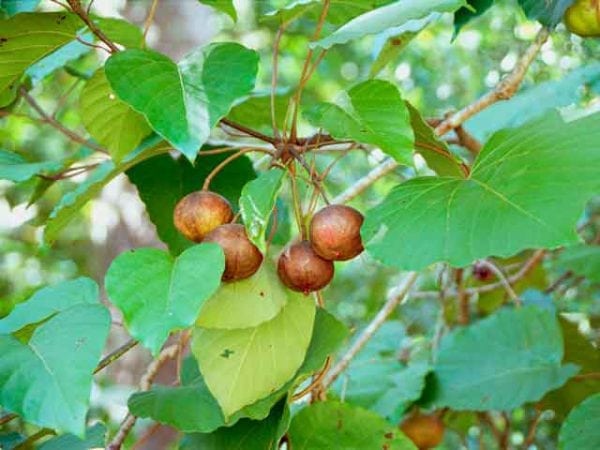Man has been using tung oil for a long time, since the time of the construction of wooden ships. Modern production of furniture and various household items also does not do without oil, and products after applying such a coating gain high quality.
- Tung oil - what is it
- Product Feature and Composition
- Properties and use of oil
- Tung oil brands
- Product Application Methods
- Storage and Precautions for Tung Oil

Tung oil - what is it
Tung oil is a tree coating product obtained from tung tree nuts. The seeds of this plant contain a huge amount of oil (70%), so the yield of the finished product from the raw materials is high. The most common tung trees in Asia (Japan, China), they are also grown in Canada, Australia, Georgia, Italy. Tentatively, more than 90,000 tons of oil are produced annually in the world.
Tunga trees belong to the family of euphorbiaceae, grow up to 20-40 meters in height, their flowers are white, have a pleasant aroma. The fruits resemble figs with large seeds inside and a thin shell, the size is up to 6–7 cm. Tung tree nuts are poisonous, their juice can cause poisoning. In the past, plant oil has been used for:
- create coverage on mahogany furniture;
- protect wood products from rotting, mold;
- tissue impregnation;
- sewing shoes;
- impregnation of boards for ships;
- inducing vomiting in patients;
- making ointments from burns and ulcers;
- refueling lamps;
- cooking soap.
There are no synthetic analogues of oil, and other oil extracts do not have such qualities suitable for wood processing. After pressing, cake is widely used in the manufacture of natural fertilizers for the soil.
to contents ↑Product Feature and Composition
The finished oil is a thick yellow liquid that has a specific smell (it seems unpleasant to some). The main properties of the material are as follows:
- good solubility in organic solvents;
- iodine number - 154-176;
- saponification - 188–198;
- density - up to 0.945 g / cm. cube;
- pour point - 0 degrees.
The composition of the product is represented by polyunsaturated fatty acids - linoleic, stearic, palmitic, eleostearic, there is also a small amount of unsaponifiable compounds. Despite the presence of components useful for humans, tung oil is not a food product, it is used only in industry and in everyday life.
to contents ↑Compared to flaxseed oil, tung can dry faster, even if a thick layer has been applied. The waterproof film, in comparison with linseed oil, is more durable, so the product is often called natural varnish.
Properties and use of oil
This technical oil is widely used for the manufacture of varnishes, paints, coatings on wooden surfaces. It is highly appreciated for the fact that it dries quickly, increases the protective properties of wood - increases wear resistance, and does not damage if alcohol or moisture gets in. Also, craftsmen love the product for giving a beautiful appearance to the coating - deep, even, thin and not shiny. Impregnation is so “eaten” into a tree that it becomes, as it were, its component.
Here are the main areas of application of the tool:
- impregnation of wooden utensils, boards for cutting food, rolling pins;
- the manufacture of expensive wooden furniture to protect it and enhance a beautiful wood pattern;
- protection of houses, baths, gazebos, other wooden structures from fungus, rot, mold, heat and cold swings;
- processing of antiques and art for their long preservation;
- restoration of paintings and other products;
- impregnation of high-quality floor coverings - boards, parquet;
- processing equipment, including electrical devices (transformers, generators, wires), automotive parts, spare parts for aircraft;
- impregnation of products in contact with fresh or salt water;
- making musical instruments.
Tung oil brands
The most popular is Borma Tung Oil (Italy), which is produced in packs of 150 ml, 0.5, 1, 5 liters. Cost per liter - 1500-1700 rubles. In a mixture with linseed, teak oil, with alkalis and paints, the product costs an order of magnitude cheaper. Half a liter of product is enough to process 7 square meters of wood flooring.
How to get a quality product? The recommendations are as follows:
- Choose an oil with 100% or pure on the packaging if you need to make a thin, natural-looking coating.
- Buy polymerized tung oil if you need to make a thick coating with gloss.
- If a green shade of the product is noted, its quality is reduced, and the highest quality oil has a honey color.
It is desirable that the raw materials for the goods grow in an ecologically clean area of the country of origin - the quality of the impregnation will not cause any complaints.
to contents ↑Product Application Methods
It is not difficult to use the material, but enough time must be devoted to the preparation of the wooden product. It must be completely dry, so after fine grinding it is dried in air, but without access to the sun. A fungus will probably start on wet wood, and even a tung hood will not protect it.
Immediately before application, the following actions should be taken:
- Remove all lint, particles and impurities, clean from wax, if any.
- Check the oil shade on a small, inconspicuous area of wood (if necessary, tinting can be added to the product).
- Large pores on the product should be filled with special means, if appropriate.
For application, take a suitable brush, lubricate the product with a thin layer. Drips, drops are removed with a soft cloth, it neatly polishes the wood. The first layer is usually made very thin, after it dries (in 8-10 hours) at a temperature of up to 25 degrees Celsius, a second layer can be applied.
Experienced experts advise to leave the material to dry for a day, and only then lubricate it with a second layer of tung oil. For even faster drying, you can dilute the product on the first layer with white spirit, and carry out subsequent layers without dilution. Usually for a fresh tree you need three layers of impregnation.
to contents ↑It is advisable to update the coating on furniture once a year - then it will serve for decades. To add shine, waxing can be performed on top of the finished coating. Subsequently, the furniture is often made red - any compositions go well with a tung hood.
Storage and Precautions for Tung Oil
Keep the product away from sources of light, fire, heat. The room should be adequately ventilated. The container is tightly closed during storage. Shelf life is usually at least 5 years. Freezing should not be allowed - its properties may deteriorate.
Despite the toxicity of the juice of the plant, the finished oil is low toxic. And yet it is used only for technical purposes, ingestion cannot be allowed! Keep packaging with goods out of the reach of children. After the work, all materials and tools can be easily washed with gasoline, turpentine.After contact with the product, wash hands and other parts of the body with soap and water. In case of contact with eyes, rinse thoroughly with warm water.











Hello!
Misunderstood, is it safe to use tung oil for wooden utensils? Or it is better to use edible oil, such as linseed.
Thank you in advance for your response!
Svetlana, Tung can be used for wooden utensils, for example, for furniture, for caskets, candlesticks, etc., that does not come in direct contact with food. but for example a sugar bowl, a candy cane, a cake bowl, etc. products, I would not recommend using tung.
Denis, it’s not clear, because it is written for processing rolling pins, chopping boards. And you write that it’s impossible even for sugar bowls, candy canes ....